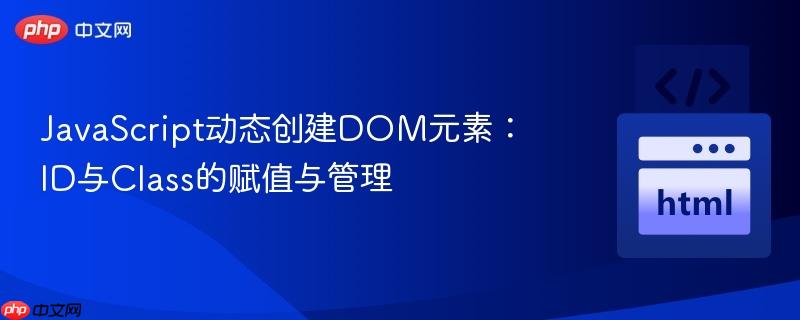
本文将深入探讨在javascript中使用`document.createelement()`动态创建dom元素后,如何高效地为其分配id和class属性。通过详细的示例代码,我们将学习如何利用`element.id`和`element.classlist.add()`等方法,实现对动态生成元素的精确样式控制和事件绑定,从而构建更具交互性和可维护性的web界面。
在现代Web开发中,JavaScript动态创建和操作DOM元素是实现交互式用户界面的核心能力。当我们使用document.createElement()方法创建新的HTML元素时,这些元素最初是“裸露”的,不带任何ID或Class。然而,为了对这些动态元素进行样式化、事件绑定或进一步的DOM操作,为其分配唯一的ID或特定的Class集合至关重要。本文将详细介绍如何在JavaScript中为动态创建的DOM元素赋值ID和Class。
ID属性在HTML中用于唯一标识一个元素。在JavaScript中,为动态创建的元素分配ID非常直接,只需访问元素的id属性并为其赋值即可。
// 创建一个div元素
const myDiv = document.createElement('div');
// 为该div元素分配一个ID
myDiv.id = 'uniqueContainer';
// 将元素添加到文档中
document.body.appendChild(myDiv);
console.log(myDiv.outerHTML); // 输出: <div id="uniqueContainer"></div>注意事项:
Class属性允许我们将样式规则或行为模式应用于多个元素。在JavaScript中,为动态创建的元素分配Class通常通过element.classList接口来实现,它提供了一系列便捷的方法来管理元素的类列表。
立即学习“Java免费学习笔记(深入)”;
使用classList.add()方法可以为元素添加一个或多个Class。
const myParagraph = document.createElement('p');
// 添加一个名为 'highlight' 的Class
myParagraph.classList.add('highlight');
// 也可以同时添加多个Class
myParagraph.classList.add('text-center', 'font-bold');
document.body.appendChild(myParagraph);
console.log(myParagraph.outerHTML); // 输出: <p class="highlight text-center font-bold"></p>classList接口还提供了其他有用的方法来管理元素的Class列表:
结合上述知识,我们来看一个从外部API获取数据,然后动态创建DOM元素并为其分配ID和Class的完整示例。
假设我们从一个API获取用户数据,并希望将每个用户的信息展示在一个容器中,并对特定的文本应用样式。
HTML (index.html)
<!DOCTYPE html>
<html lang="en">
<head>
<meta charset="UTF-8">
<meta http-equiv="X-UA-Compatible" content="IE=edge">
<meta name="viewport" content="width=device-width, initial-scale=1.0">
<link rel="stylesheet" href="./styles.css">
<title>动态DOM元素与样式</title>
</head>
<body>
<section id="customer-list-section">
<h2>用户列表</h2>
</section>
<script src="./app.js"></script>
</body>
</html>CSS (styles.css)
body {
font-family: Arial, sans-serif;
margin: 20px;
background-color: #f4f4f4;
}
#customer-list-section {
max-width: 800px;
margin: 0 auto;
background-color: #fff;
padding: 20px;
border-radius: 8px;
box-shadow: 0 2px 4px rgba(0, 0, 0, 0.1);
}
.customer-card {
border: 1px solid #ddd;
padding: 15px;
margin-bottom: 10px;
border-radius: 5px;
background-color: #f9f9f9;
}
.customer-name {
color: #333;
font-size: 1.2em;
font-weight: bold;
margin-bottom: 5px;
}
.customer-details {
color: #666;
font-size: 0.9em;
line-height: 1.5;
}
/* 特定ID和Class的样式 */
#first-customer-name {
color: darkred;
font-size: 1.5em;
text-decoration: underline;
}
.highlight-email {
color: blue;
font-weight: bold;
}const customerListSection = document.getElementById("customer-list-section");
const requestURL = "https://jsonplaceholder.typicode.com/users";
fetch(requestURL)
.then((response) => response.json()) // 直接解析为JSON对象
.then((users) => DisplayUserInfo(users))
.catch((error) => console.error("Error fetching user data:", error));
function DisplayUserInfo(userArray) {
userArray.forEach((user, index) => {
// 创建一个div作为每个客户的容器
const customerCard = document.createElement("div");
customerCard.classList.add("customer-card"); // 添加通用Class
// 创建一个p元素显示客户姓名
const customerNameParagraph = document.createElement("p");
customerNameParagraph.classList.add("customer-name");
customerNameParagraph.textContent = `客户: ${user.name}`;
// 为第一个客户的姓名元素分配一个特定ID
if (index === 0) {
customerNameParagraph.id = "first-customer-name";
}
// 创建一个span元素显示其他详细信息
const customerDetailsSpan = document.createElement("span");
customerDetailsSpan.classList.add("customer-details");
customerDetailsSpan.innerHTML = `
ID: ${user.id} <br>
邮箱: <span class="highlight-email">${user.email}</span> <br>
用户名: ${user.username}
`;
// 将姓名和详细信息添加到客户卡片中
customerCard.appendChild(customerNameParagraph);
customerCard.appendChild(customerDetailsSpan);
// 将客户卡片添加到页面上的section中
customerListSection.appendChild(customerCard);
});
}在这个示例中:
通过这种方式,我们可以在JavaScript中灵活地控制动态创建元素的ID和Class,从而实现精细的样式控制和交互逻辑。
掌握这些技巧将使您能够更有效地利用JavaScript动态构建和管理Web页面,创建出功能强大且美观的用户界面。
以上就是JavaScript动态创建DOM元素:ID与Class的赋值与管理的详细内容,更多请关注php中文网其它相关文章!

每个人都需要一台速度更快、更稳定的 PC。随着时间的推移,垃圾文件、旧注册表数据和不必要的后台进程会占用资源并降低性能。幸运的是,许多工具可以让 Windows 保持平稳运行。

Copyright 2014-2025 https://www.php.cn/ All Rights Reserved | php.cn | 湘ICP备2023035733号